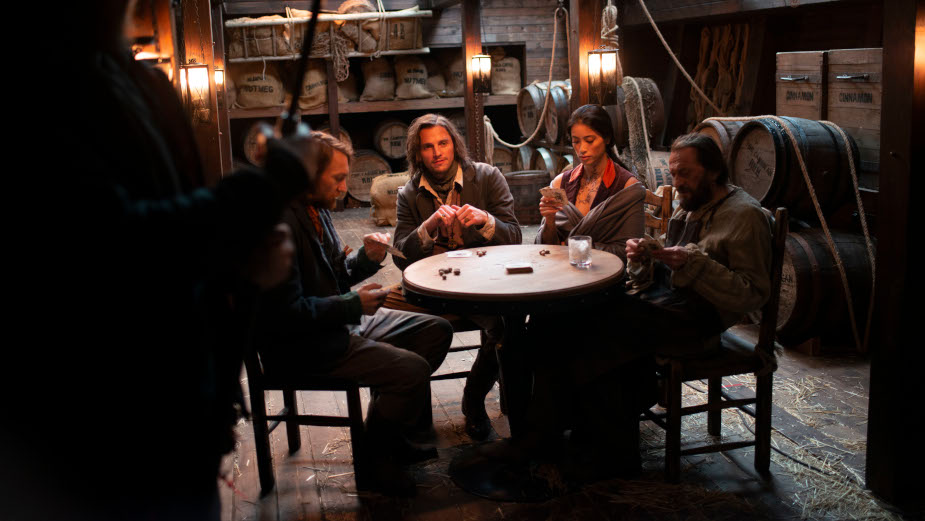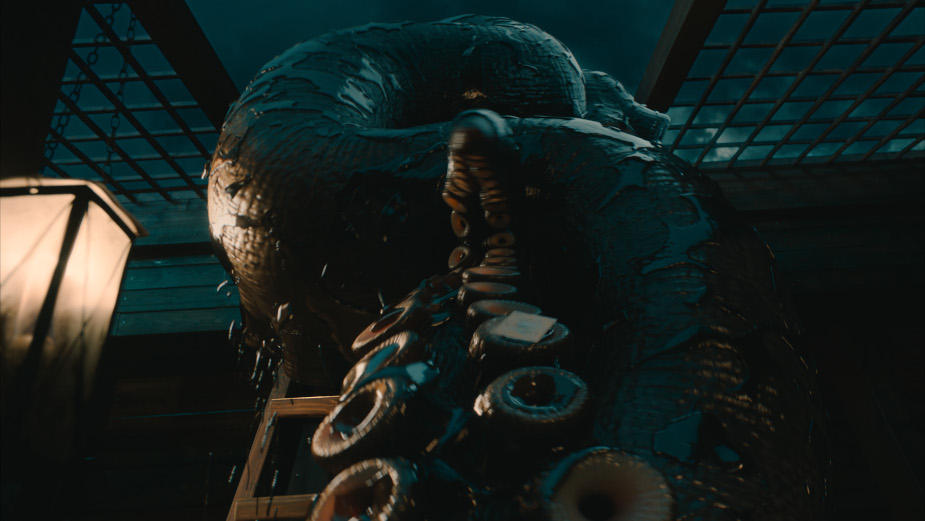
Behind the Tentacle Tale of the Monstrous Kraken’s Return

The Kraken Black Spiced Rum has recently been launched in Australia and the UK. So, to celebrate the new beginning, Purple Creative and production company Fight Gravity, came together with the brand to delve deeper into its origins - the story of the Kraken and its obsession with Caribbean rum, dating all the way back to 1870.
This resulted in a 30-second epic, filled with characters with rich backstories, tentacles with tons of personality and a deadly game of cards. Steve Bewick, creative director at Purple Creative, says that while the brief was to tell the origin story of The Kraken Rum, the team wanted to avoid making a children’s pirate movie at all costs. That strive towards a realistic feel brought them to an interesting crux, which is where the project blossomed: “We were on the line between telling a legendary story, while at the same time, educating people about the rum.”
“The idea is that the beast is obsessed with the rum,” adds Steve. “Its heightened sense of smell means it tracked the trading ship across the slate-grey waters of the Atlantic. After the ferocious attack, the ship was lost, along with all but one of the barrels of rum, which was badly stained by the Kraken’s black ink. It was dubbed ‘The Kraken Black Spiced Rum’. And the rest is history…”
LBB’s Zoe Antonov spoke to Steve, and Fight Gravity producer Paul Cheung, about the many dimensions of this project and why it has “all the qualities that people dream about when they get into filmmaking and production.”
LBB> Why was mixing live action and animation the best way to go about the project?
Paul Cheung> The brief was clear from the start - we were tasked with creating a world that imagined what it would actually be like if The Kraken existed. So live action was a key part of the equation. We did consider using ‘puppet tentacles’ to mimic real tentacles but knew that these would still just be placeholders – we’d still have to animate over the top of them. The advantage would be that the actors would have physical interaction, but in the end, it was testament to our actors’ talent that they were able to realistically interact with ‘air’.
Initially, there were discussions to rely more on a virtual studio – but it quickly became apparent that in order to create the destruction that we needed (and to have real water streaming onto the set), doing a live action shoot was the only way.
LBB> Tell us about the characters inside the ship! They all have backstories, so how did you come up with them and what went into deciding who they are?
Paul Cheung> The backstories came from the mind of Jamie Fleming, Purple copywriter, peppered with some intriguing character traits from Rudolf Peter Kiss, our director. The cool thing about the backstories is that they aren’t just ideas thrown at the wall, they actually make sense and feed into how each character behaves and dresses. Case in point: our hero Jeremiah Hill is the second son of an English aristocrat who fled his prescribed life (which he keeps secret from everyone). The only symbol of his past is concealed beneath his attire: a family signet ring suspended on a gold chain.
When the hero dives into the water at the end and swims past the giant Kraken eye, you can actually see the ring dangling from his neck. Visually, it adds that certain something and story-wise, it belies a whole narrative thread.
Having a hero seems so obvious now but in the initial boards, the action was less centred around a single person’s action and more just a blend of absolute chaos. Although that still would have made a super cool ad, the director felt that to get the audience to care about our characters, their journey, and ultimately the Black Spiced Rum, there had to be a hero figure. The result is an ad that stands up to repeat viewing because we have someone to root for and be interested in.

Above: the actors' table
LBB> How did you create the ship itself?
Paul Cheung> The ship we used as the reference was one of the most important discussions in pre-production. How era-specific did it have to be? In the end we decided it should be a tea-clipper in the 1870s… So what better ship to base it on than the world-famous Cutty Sark?
The ship build you see in the ad is as real as it gets – each beam of wood is heavy, solid timber. A lot of film sets are façade only… but honestly, I think if the team had to build an entire ship, we could have set sail.
The downside of having real wood is that when the tentacle ‘breaks through’ the ship, the battering rams had to be manned by several crew to be able to deliver enough power to break the sides.
Our pre-production phase was very short (considering the size of the project) – that’s why the team was working flat out for over two weeks to construct the ship’s hold.
The only visual ‘trickery’ that you see is that to create the notion of an ‘upper deck’, we had stairs going up (albeit to nowhere) and we had a large light source beaming through the holes in the ceiling as ‘moonlight’.
LBB> How did you manage to achieve a sense of movement on a static set? Just very good acting - or were other tricks involved as well?
Paul Cheung> We synchronised the swinging lanterns with the rotation of the camera (we had a special rig called an AR Omega and a camera operator who was able to rotate the camera 360 degrees). The camera operator was actually the Steadicam op from ‘Dune’ – it was essential that we had one of the best operators in the world as the camerawork is so technical and full of nuance.
LBB> You mention there’s a lot of easter eggs throughout - can you point us to some of them?
Steve Bewick> There are lots of fun references for brand enthusiasts to find – although a lot can be missed in the action!
Key ones include a Kraken tattoo on the quartermaster’s neck, a lighthouse calendar on the table (a nod to new expressions being launched in the near future), spices used for poker chips, the Kraken icon on the back of the playing cards, a whittled wooden Kraken carving on the table, a hanging lantern bottle that shows the original Victorian bottle shape and hessian sacks in the background with ‘roast coffee’ stencilled on them to hint at the brand’s most recent flavour extension.
LBB> Tell us more about the making of the Kraken itself - what were the biggest challenges? What are some details we might have missed?
Steve Bewick> The whole thing was shot over two days in a Hungarian studio just outside Budapest. To fit it all in, we worked very long days! Everything was set up beforehand and planned down to the last second, we shot in one studio for the water shots and the other for the interior of the ship’s hold. The stunts were the most fun for us watching - not sure about the actors though! The biggest challenge was cramming everything we wanted into a 30-second film and still creating a narrative arc – building the pace, from the calm to the attack.


Above: The Kraken eye underwater
Paul Cheung> The biggest challenge was telling a coherent story in the time we had – and in particular, telling a story without using dialogue. It’s in large part down to the skill of Rudolf Peter Kiss, our director, that he was able to bring depth and character development despite only having 30 seconds!
The most fun part was finally seeing all the tentacles on screen and interacting with the crew – up till that point, we only had our imaginations to rely on.
One detail that not many will know is that the fully realised tentacles, with all the textures, lighting and colour don’t make their way onto their screen until the very last moment – up until the week or two before delivery, the team were constantly tinkering away on tentacle movement, scale, behaviour – we only add the bells and whistles when everyone is happy. So the pressure by the end is enormous but also massively adrenalising.
When the hero is flung back by the Kraken’s ink spurt, we pulled off this stunt by tying a harness and rope to the actor. Off screen, there are a couple of stunt crew holding the other end of the rope and when the moment comes, they jump off their vantage point and our hero goes flying. There were several days of testing this move – in fact the crew tested it over and over again in the stunt person’s garden to get the distance and explosiveness just right.

Above: stunt rehearsal
LBB> How did you manage to give the tentacles such personality?
Paul Cheung> Each tentacle had its very own animator and each pairing was chosen based on their animation style. So in many ways the tentacles literally reflect their creators! Some animators naturally infused the tentacle with humour – so they would be assigned the tentacle on the stairs or the tentacle slapping the table for instance, whereas some animators would be colder and more calculating – so they would be assigned the tentacles which break into the ship. That’s not to say that the animator’s personality was cold or calculating, it just so happens they like to animate that way!

Above: tentacle close-up
LBB> And how about the eye of the Kraken - what was important when animating that?
Paul Cheung> The Kraken eye had a particularly interesting evolution. When you look at early iterations, you can see influences of a dolphin, a squid, an octopus – all seemingly logical given the space we’re in… but all ultimately not quite right. They all seemed a bit too friendly and personable, whereas the brand was looking for something wilder and more ferocious. What we realised is that instead of working up artwork as if illustrating an encyclopaedia, it was better to work on the eye in our actual scenes. We played with scale, position, angle and even blinking to devise the perfect Kraken eye. I love the slight flinch when our hero goes towards it when he falls in the water.
LBB> Any final thoughts?
Steve Bewick> Don’t work with sea monsters unless you have an awesome crew! It was a fantastic experience – from first thoughts to finished ad – and we’re incredibly proud of the results, which seem to have been embraced enthusiastically by markets all over the world.
Paul Cheung> It’s a rare privilege to work on an ad that features all the qualities that we dream about when we get into filmmaking and production. Story, visual effects, interesting characters, action, stunts and a brand/product that syncs with the world you see on screen. Having just a few of these aspects together is incredible but having all of them together is practically unheard of. Loved it.













